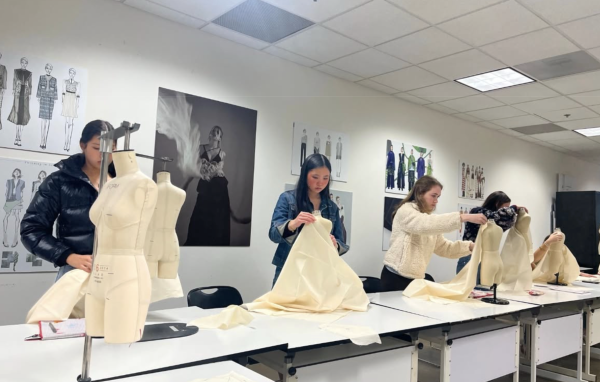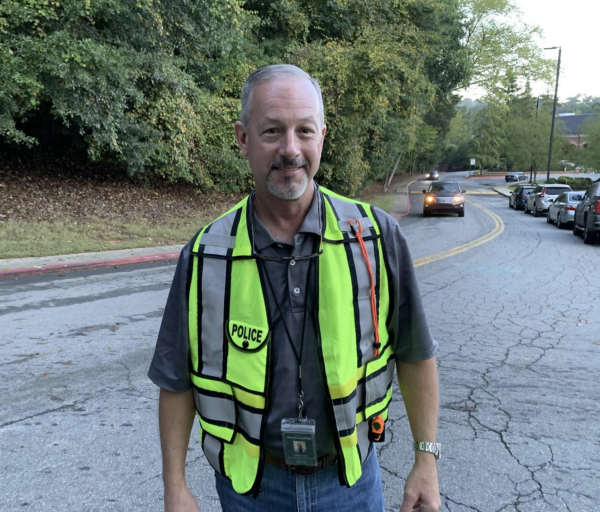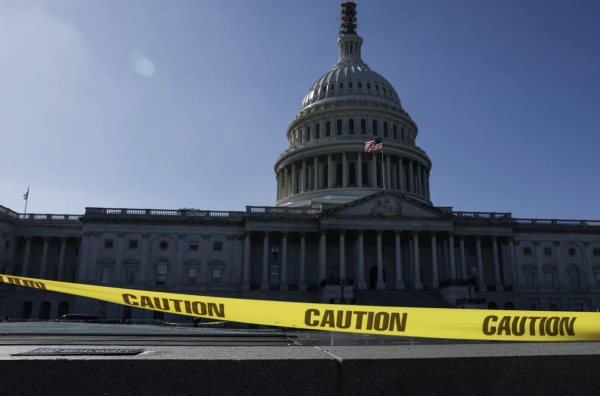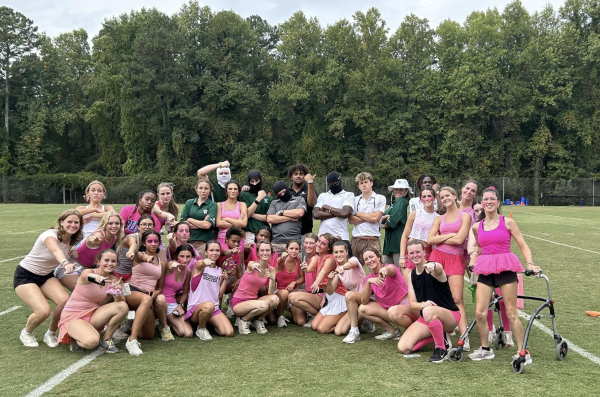“The Campus Walls” outdoor art exhibit installed
If you are a Westminster student walking the pathways between the school buildings this April, chances are you noticed the new outdoor art display featured on various building walls and the sidewalks. These pieces are a part of the first outdoor art exhibit at Westminster, called “The Campus Walls.”
The project was started last year by students in the advanced junior-level photography and graphic design classes, but the exhibition was delayed to this spring due to the pandemic. However, artists were still able to continue their work at home. With the help of Photoshop, student artists were able to create mock-ups of their art superimposed on specific building walls or ground areas, allowing them to see how their finalized projects would look when completed and displayed.
“The main idea was to engage the community in a way that would allow all students to see art pieces interacting with the environment,” said visual arts department chair Benjamin Steele, who supervised the project. “We wanted the students to design massive-scale pieces intended to be in specific locations visible to the public.”
Despite having to tailor their art to specific locations around the campus, the student artists had creative license to do what felt more natural and even personal to them. Some of the pieces started around students’ concentration work for advanced art classes. Senior Akshadha Lagisetti started her piece as a part of her 2D Portfolio class last year and completed the project this year.
“My piece examines the idea of the curiosity of the unknown from a woman’s perspective,” said Lagisetti. “Within the given space, I wanted to emphasize women discovering knowledge and a progression in exploration over time.”
While some of the displayed art addresses the artist’s personal experiences, many of the art pieces reflect their convictions and views about current issues. For instance, senior Eleanor Carroll uses art as a vehicle to deliver powerful messages.
“My pieces are all about how the media created fragmented realities for women by forcing them to create different versions of themselves in order to fit into today’s society,” said Carroll. “I wanted to bring awareness to the impact that social media has on women, and the dangerous expectations social media places on women both mentally and physically.”
Some of the project’s pieces were created specifically to explore current and sensitive topics and generate thought. Senior Cabot Kimball, for example, created a piece which addresses the issues of sensationalizing violence in the media.
“I created my piece by combing through newspapers and cutting out articles and scanning them into the computer,” said Kimball. “I then collaged them together in Photoshop and created the overlay of the hands. I hoped that people would see it and realize how prevalent violence is in our media and the atmosphere that it creates.”
All of the featured artists are students involved in advanced art classes. While most of the students had their art displayed in exhibitions before, none of them have been previously engaged in an outdoor project of this kind. Having their art enlarged and displayed prominently for all passersby was a novel and intriguing experience for all.
“To see a photograph that you made or a design you created blown up to wall size is interesting,” Steele said. “It definitely changes the way you see the work you’ve been doing.”
While the outdoor art project idea was exciting for the students involved, bringing it to fruition was challenging. Since the exhibition was outdoors, the display came with special logistical issues that more traditional indoor art features don’t encounter. The massive size of the pieces displayed was an important part of the issue.
“Because most of the art had to be attached directly to building walls or placed on the ground, one of the most challenging parts of the project was transferring the existing art onto appropriately sized material that could be displayed without damaging the walls or other structures,” said Steele. “We also had to take into consideration the cost of printing massive renditions of art pieces.”
Students mitigated some of the issues related to the massive size of the final project by using special tools and techniques. Since each specific piece had to fit its preselected space, the methods employed had to be both creative and precise.
“We basically had to take our art pieces and first blow it up,” said Lagisetti. “Then we had to divide the images into smaller, printer paper-sized sheets and print each section separately. After that, we assembled the final project onto a canvas by pasting each piece together like a puzzle and displayed it outside.”
Unfortunately, due to exposure to the elements and a particularly windy and rainy season, many of the art pieces degraded quickly, and some had to be removed only days after being displayed. Even though the exhibition was short-lived, the organizers were pleased with its impact on the Westminster community.
“We knew that the project was designed to be temporary,” said Steele. “Putting the pieces out in the open means that you accept what happens to it, and you make your peace with the fact that it’s going to fade. We achieved our goal, though. We wanted to create a situation where a person could just encounter art, as opposed to making a decision to go to an art space to see it. This project was a very good way of forcing someone to be confronted with art and deal with its meaning. It was a positive and fruitful interruption of daily life.”









